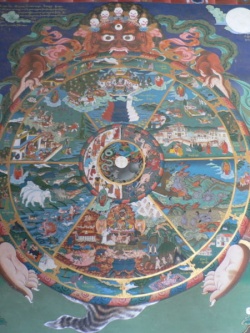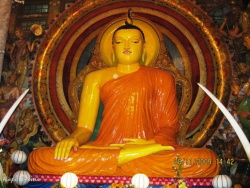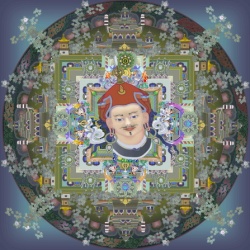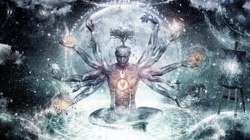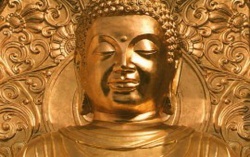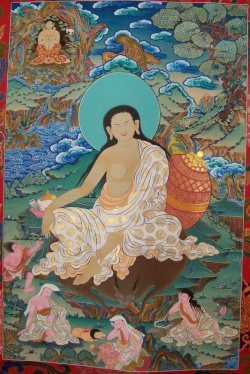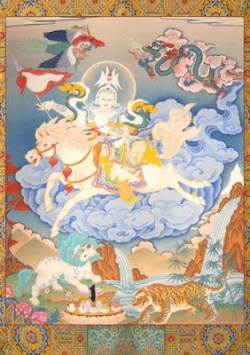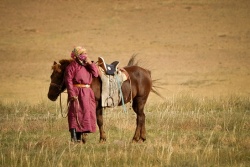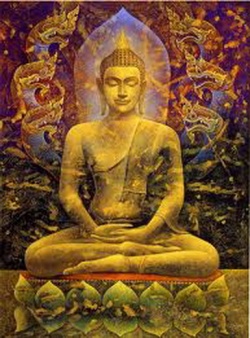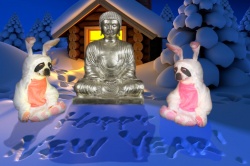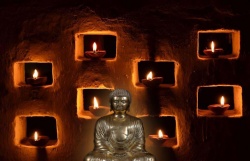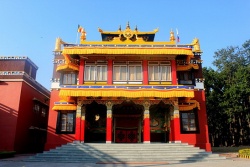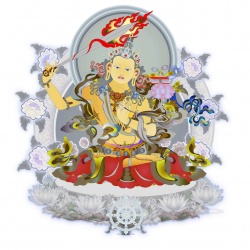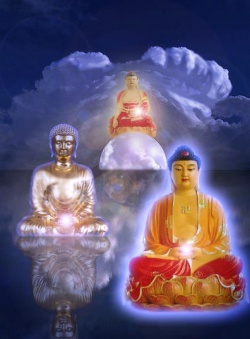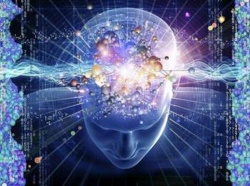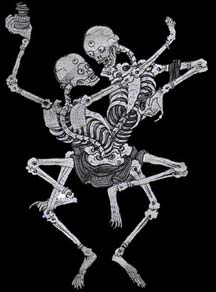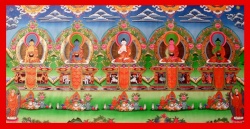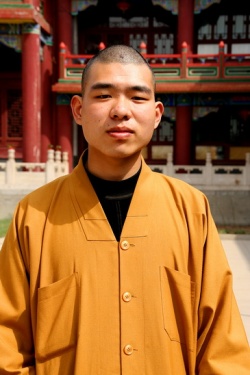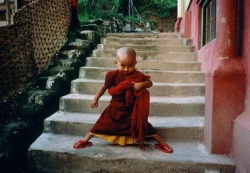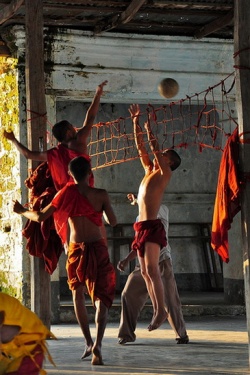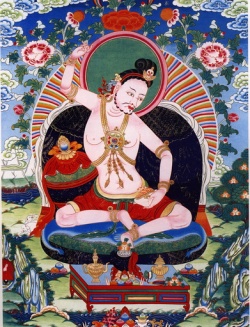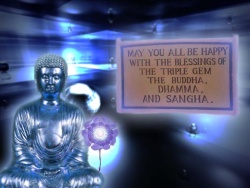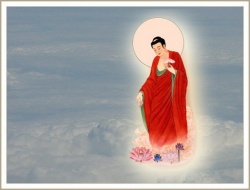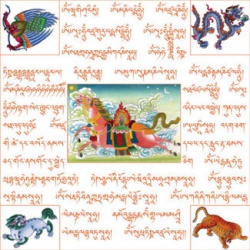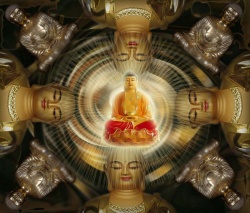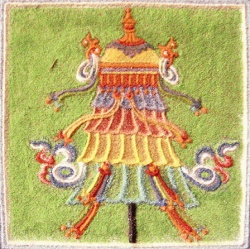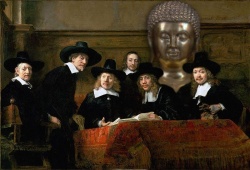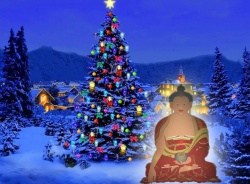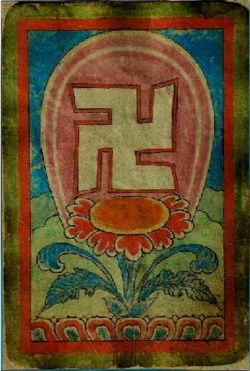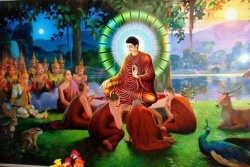Saṃsāra
輪廻 (Skt, Pali; Jpn rinne ) Samsara This can be understood in two ways – as uninterrupted rebirth without freedom or control, or as the aggregates of a being who has taken such a rebirth.
Samsara, sometimes known as ‘cyclic existence’, is characterized by suffering and dissatisfaction. There are six realms of samsara.
Listed in ascending order according to the type of karma that causes rebirth in them, they are the realms of the hell beings, hungry spirits, animals, human beings, demi-gods, and gods.
The first three are lower realms or unhappy migrations, and the second three are higher realms or happy migrations.
Although from the point of view of the karma that causes rebirth there, the god realm is the highest realm in samsara, the human realm is said to be the most fortunate realm because it provides the best conditions for attaining liberation and enlightenment.
Transmigration
The cycle of birth and death that ordinary people undergo in the world of illusion and suffering.
In India, the theory of transmigration first appeared in Upanishad philosophy, before the rise of Buddhism, in the eighth or seventh century B.C.E.
Buddhism holds that ordinary people undergo an endless cycle of birth and death within the threefold world (the worlds of desire, form, and formlessness) and among the six paths (the realms of hell, hungry spirits, animals, asuras, human beings, and heavenly beings).
This repeated cycle of birth and death in the realms of illusion and suffering is referred to as "transmigration in the six paths."
Unenlightened beings are born into one of the six paths in accordance with their actions in their previous existence;
when the present life is over, they are reborn in the same or another of the six paths, repeating this process so long as they fail to free themselves from it.
The Buddhist concept of emancipation (Skt vimoksha ) means liberation from this repeated cycle of birth and death in the realms of illusion and suffering.
Freeing oneself from transmigration in the six paths was considered the goal of Buddhist practice.
The causes for such transmigration were regarded as ignorance of the true nature of life and selfish craving.
Liberation from them required awakening to the truth and eliminating selfish craving, and was considered to lead to the attainment of nirvana, or emancipation.
Saṃsāra (Sanskrit, Pali; also Samsara) is a Buddhist term that literally means "circle" or "wheel" and is commonly translated as "conditioned existence", "cyclic existence", "cycle of existence", etc.
Within Buddhism, Samsara is defined as the continual repetitive cycle of birth and death that arises from ordinary beings' grasping and fixating on a self and experiences.
Specifically, Samsara refers to the process of cycling through one Rebirth after another within The Six Realms of existence, where each realm can be understood as physical realm or a psychological state characterized by a particular type of Suffering.
Samsara arises out of Avidya (ignorance) and is characterized by Dukkha (Suffering, anxiety, dissatisfaction).
In the Buddhist view, liberation from Samsara is possible by following the Buddhist path.
Overview
Samsara is the continual repetitive cycle of birth and death that arises from ordinary beings' grasping and fixating on a self and experiences.
Specifically, Samsara refers to the process of cycling through one Rebirth after another within The Six Realms of existence.
Each of these six realms can be understood as a physical realm or a psychological state characterized by a specific type of Suffering.
The nineteenth century Tibetan Lama Patrul Rinpoche explains the cyclic nature of Samsara as follows:
- The term Samsara, the wheel or round of existence, is used here to mean going round and round from one place to another in a circle, like a potter's wheel, or the wheel of a water mill.
When a fly is trapped in a closed jar, no matter where it flies, it can not get out.
Likewise, whether we are born in the higher or lower realms, we are never outside Samsara.
The upper part of the jar is like the higher realms of gods and men, and the lower part like the three unfortunate realms.
It is said that Samsara is a circle because we turn round and round, taking Rebirth in one after another of The Six Realms as a result of our own actions, which, whether positive or negative, are tainted by clinging.
Contemporary scholar Rupert Gethin emphasizes this point as follows:
- ...beings generally rise and fall, and fall and rise through the various realms, now experiencing unhappiness, now experiencing happiness. This precisely is the nature of saṃsāra: wandering from life to life with no particular direction or purpose."
Samsara arises out of Avidya (ignorance) and is characterized by Dukkha (Suffering, anxiety, dissatisfaction).
Realms of existence
- See also: Six realms, Bhavacakra
Buddhist cosmology typically identifies six realms of existence: gods, demi-gods, humans, animals, hungry ghosts and hells. These realms can be understood both as psychological states and as aspects of Buddhist cosmology.
These six realms are typically divided into three higher realms and three lower realms:
the three higher realms are
the realms of the gods demi-gods, and humans;
the three lower realms are
the realms of the animals, hungry ghosts and hell beings.
These realms can be described briefly as follows:
- God realm: the gods lead long and enjoyable lives full of pleasure and abundance, but they spend their lives pursuing meaningless distractions and never think to practice the dharma.
When death comes to them, they are completely unprepared;
without realizing it, they have completely exhausted their good Karma (which was the cause for being reborn in the god realm) and they suffer through being reborn in the lower realms.
- Demi-god realm: the demi-gods have pleasure and abundance almost as much as the gods, but they spend their time fighting among themselves or making war on the gods.
When they make war on the gods, they always lose, since the gods are much more powerful.
The demi-gods suffer from constant fighting and jealousy, and from being killed and wounded in their wars with each other and with the gods.
- Human realm: humans suffer from hunger, thirst, heat, cold, separation from friends, being attacked by enemies, not getting what they want, and getting what they don't want.
They also suffer from the general sufferings of birth, old age, sickness and death.
Yet the human realm is considered to be the most suitable realm for practicing the Dharma, because humans are not completely distracted by pleasure (like the gods or demi-gods) or by pain and Suffering (like the beings in the lower realms).
- Animal realm: wild animals suffer from being attacked and eaten by other animals; they generally lead lives of constant fear.
Domestic animals suffer from being exploited by humans; for example, they are slaughtered for food, overworked, and so on.
- Hungry ghost realm: hungry ghosts suffer from extreme hunger and thirst.
They wander constantly in search of food and drink, only to be miserably frustrated any time they come close to actually getting what they want.
For example, they see a stream of pure, clear water in the distance, but by the time the get there the stream has dried up.
Hungry ghosts have huge bellies and long thin necks. On the rare occasions that they do manage to find something to eat or drink, the food or water burns their neck as it goes down to their belly, causing them intense agony.
- Hell realm: hell beings endure unimaginable Suffering for eons of time.
There are actually eighteen different types of hells, each inflicting a different kind of torment.
In the hot hells, beings suffer from unbearable heat and continual torments of various kinds.
In the cold hells, beings suffer from unbearable cold and other torments.
Benefits of the human realm
Among The Six Realms, the human realm is considered to offer the best opportunity to practice the Dharma, thereby offering the best chance to attain liberation from Samsara.
Dzongsar Khyentse explains:
- If we need to judge the value of these six realms, the Buddhists would say the best realm is the human realm. Why is this the best realm? Because you have a choice...
The gods don’t have a choice.
Why? They’re too happy. When you are too happy you have no choice. You become arrogant. The hell realm: no choice, too painful.
The human realm: not too happy and also not too painful.
When you are not so happy and not in so much pain, what does that mean?
A step closer to the normality of mind, remember? When you are really, really excited and in ecstasy, there is no normality of mind.
And when you are totally in pain, you don’t experience normality of mind either. So someone in the human realm has the best chance of acquiring that normality of mind.
And this is why in Buddhist prayers you will always read: ideally may we get out of this place, but if we can’t do it within this life, may we be reborn in the human realm, not the others.
Equivalence of cosmology and psychology
From the Buddhist point of view, the realms of Samsara are descriptions of both psychological states of mind and physical cosmological realms.
From the Buddhist perspective, Rebirth in the different realms is determined by our Karma, which is directly determined by our psychological states.
For example, a feeling of anger can be said to lead to "Rebirth" into a new "realm":
this Rebirth can be viewed on an instantaneous level, in which being angry can make someone feel very "heated", or on a longer-term level,
in which a habitual tendency to anger can cause someone to be reborn into a "heated" situation.
An extreme habituation to anger and violence can lead to Rebirth in one of the "hell realms".
On the other hand, feelings of compassion and love can lead to Rebirth in the realms where these feelings are dominant (such as certain god realms, or particular situations within the human or animal realms).
Rupert Gethin explains this equivalence of cosmology and psychology from the Buddhist perspective.
Gethin states:
- The key to understanding the Buddhist cosmological scheme lies in the principle of the equivalence of cosmology and psychology.
I mean by this that in the traditional understanding the various realms of existence relate rather closely to certain commonly (and not so commonly) experienced states of mind.
In fact Buddhist cosmology is at once a map of different realms of existence and a description of all possible experiences. This can be appreciated by considering more fully the Buddhist understanding of the nature of Karma.
At root Karma or ‘action’ is considered a mental act or intention; it is an aspect of our mental life:
‘It is “intention” that I call Karma; having formed the intention, one performs acts (Karma) by body, speech and mind.’
Aṅguttara Nikāya iii. 415; cf. Atthasālinī 88–9.
Thus acts of body and speech are driven by an underlying intention or will (cetanā) and they are unwholesome or wholesome because they are motivated by unwholesome or wholesome intentions.
Acts of body and speech are, then, the end products of particular kinds of mentality.
At the same time Karma can exist as a simple ‘act of will’, a forceful mental intention or volition that does not lead to an act of body or speech.
Generally speaking, each realm is said to be the result of one of the six main negative emotions: pride, jealousy, desire, ignorance, greed, and anger. Dzongsar Jamyang Khyentse explains:
- So we have six realms. Loosely, you can say when the perception comes more from aggression, you experience things in a hellish way.
When your perception is filtered through attachment, grasping or miserliness, you experience The Hungry Ghost Realm.
When your perception is filtered through ignorance, then you experience the animal realm.
When you have a lot of pride, you are reborn in the god realm.
When you have jealousy, you are reborn in the asura (demi-god) realm. When you have a lot of passion, you are reborn in the human realm.
Body and mind under the influence of Kleshas and Karma
Contemporary Buddhist teacher Thubten Chodron emphasizes that Samsara is not a place or external environment, but rather Samsara refers to one's own body and mind under the influence of Kleshas (disturbing emotions) and Karma. Thubten Chodron states:
- We tend to say, “Oh yes. This is Samsara.
We’re all in Samsara.” And we tend to think the external environment is Samsara. We think, “America is Samsara.”
Don’t we? We say, “Samsara is too much!”, meaning my job’s too much, everything around me is too much, I’ve got to get out of Samsara – where’s the airplane? But Samsara actually is not the environment we live in.
- Samsara is our body and mind under the influence of kleshas and Karma. Our body and mind that make us continually circle within The Six Realms.
Samsara can refer to the present body and mind, or it can refer to our process of circling in The Six Realms, taking one body and mind after another body and mind – body and mind of a god, body and mind of A Hell Being, body and mind of a human, body and mind of a hungry ghost.
That’s Samsara.
That’s cyclic existence.
- When we say we want to generate the determination to be free of Samsara, it’s not that we have to move out of Seattle.
It’s we have to free ourselves from the body and mind that are under the influence of kleshas and Karma.
That’s a very important point to understand.
The environment does influence us, but it’s not the environment that’s the root problem. Of course we have to choose our environment well so that we can practice well,
but we have to remember that the basic problem is being under the control of the kleshas and Karma which cause us to take a body and mind and have unsatisfactory experiences, over and over again.
Characteristics
Dukkha
Samsara is characterized by Dukkha (Suffering, anxiety, dissatisfaction).
Impermanent
Samsara is also characterized by impermanence.
Contemporary scholar Paul Williams explains:
- All Rebirth is due to karman and is impermanent.
Short of attaining Enlightenment, in each Rebirth one is born and dies, to be reborn elsewhere in accordance with the completely impersonal causal nature of one's own karman.
The endless cycle of birth, Rebirth, and redeath, is Samsara.
No evident beginning
From the Buddhist point of view, all beings have been Suffering in Samsara for an unimaginable period of time, and they will continue to do so until they attain liberation.
For example, the Assu Sutta of the Pali Canon states:
- At Savatthi. There the Blessed One said: "From an inconstruable (sic) beginning comes transmigration.
A beginning point is not evident, though beings hindered by ignorance and fettered by craving are transmigrating & wandering on.
What do you think, monks:
Which is greater, the tears you have shed while transmigrating & wandering this long, long time—crying & weeping from being joined with what is displeasing, being separated from what is pleasing—or the water in the four great oceans?"
Habitual, repetitive pattern
The nature of Samsara is a habitual, repetitive pattern. Ajahn Sucitto explains:
- The pattern is that each new arising, or “birth” if you like, is experienced as unfulfilling.
In this process of ongoing need, we keep moving from this to that without ever getting to the root of the process.
Another aspect of this need is the need to fix things, or to fix ourselves—to make conflict or pain go away.
By this I mean an instinctive response rather than a measured approach of understanding what is possible to fix and what Dukkha has to be accommodated right now. Then there’s the need to know, to have it all figured out.
That gets us moving too.
This continued movement is an unenlightened being’s response to Dukkha.
That movement is what is meant by samsāra, the wandering on.
According to The Buddha, this process doesn’t even stop with death—it’s like the habit transfers almost genetically to a new consciousness and body. But even within this life, we can see all these “births,”
or as The Buddha put it, birth—the same habit taking different forms.
And each new birth is unsatisfactory too, because sooner or later we meet with another obstacle, another disappointment, another option in the ongoing merry-go-round. High-option cultures just give you a few more spins on the wheel.
Cause
The root cause of Samsara is ignorance (Avidya)–belief in a single, independently-existing self.
Ignorance gives rise to the Three poisons, which lead to the creation of Karma, which leads to Rebirth in The Six Realms of existence.
Liberation
In the Buddhist view, beings can liberate themselves from Samsara by following the Buddhist path. For example, the Dalai Lama explains:
- To attain liberation from Samsara one must perfect the three higher trainings: self-discipline, meditative concentrationd the wisdom of emptiness.
In a sense, the most important of these is the wisdom of emptiness; for when we understand the empty, non-inherent nature of the self and phenomena,
the endless forms of delusion that arise from grasping at true existence are directly eliminated.
However, in order for the training in Wisdom to mature and become strong, one must first develop meditative concentration;
and in order to develop and support concentration one should cultivate the training in self-discipline, which calms the mind and provides an atmosphere conducive to meditation.
When one practices all three of these higher trainings and takes them to perfection, liberation from Samsara is definite.
The Dalai Lama also emphasizes the importance of understanding the nature of Samsara in order to be liberated from it.
He states: "one must understand the nature and patterns of the general sufferings that pervade all of Samsara, as well as the specific sufferings of the individual realms, particularly the three lower realms.
Relation to other Buddhist concepts
Rebirth
- See also:Rebirth
Saṃsāra is the recurring cycle of Rebirth throughout The Six Realms.
Some non-Buddhist traditions believe that when one goes through the process of Rebirth that there is a permanent self (i.e. a soul or Atman) that is reborn.
In the Buddhist view, there is not a permanent, instrinsically existing soul or Atman.
In the Buddhist view, there is a transfer of consciousness from one life to the next, but this consciousness is a continuum (e.g. a continually evolving stream of consciousness) rather than a permanent entity.
One example used to explain this transfer of consciousness from one life to the next is that it is “Like a billiard ball hitting another billiard ball.
While nothing physical transfers, the speed and direction of the second ball relate directly to the first." Thus, the previous life has a direct impact on the next life.
Karma
- See also:Karma
The driving force behind Rebirth in The Six Realms of Samsara is Karma.
Sogyal Rinpoche explains:
- The truth and the driving force behind Rebirth is what is called Karma. Karma is often totally misunderstood in the West as fate or predestination; it is best thought of as the infallible law of cause and effect that governs the universe.
The word Karma literally means “action,” and Karma is both the Power latent within actions, and the results our actions bring.
In the Buddhist view, therefore, the type of birth we have in this life is determined by our actions or Karma from our previous life; and the circumstances of our future Rebirth are determined by our actions in this life.
This view does not imply any blame or judgement of beings who are born into difficult circumstances or into the lower realms.
From the Buddhist point of view, all beings have been circling in Samsara from beginningless time, sometimes in the upper realms, sometimes in the lower realms,
so there is justification for judging beings who are less fortunate then ourselves, since we have all experienced every type of misfortune and good fortune in our previous lifetimes.
In the Buddhist view, a proper understanding of Samsara will lead one to have compassion for all beings, including ourselves, who are trapped in this cycle of birth and death.
Thubten Chodron explains that a proper understanding of Samsara can help us take responsibility for our present situation, but without blaming ourselves. Thubten Chodron states:
- This means taking responsibility for our own situation, which is not the same as blaming ourselves. We don’t blame ourselves. It’s not that we’re bad people because we’re in Samsara.
It’s not that we’re sinners and we deserve to suffer, or any of that kind of stuff, but it’s just when I’m not mindful, when I don’t take care of myself, when I don’t explore what’s reality and what isn’t, I continually get myself into messes.
In some ways this is very empowering because if we get ourselves into the messes, we’re also the ones who can get ourselves out of them.
All we have to do is stop creating the causes.
It’s not a question of perpetuating some external being so that they bestow grace or they move the puppet strings differently.
It’s a thing of generating our own Wisdom and compassion, bringing those to the forefront, and then freeing ourselves. Buddhas and bodhisattvas help, of course. They influence us.
They guide us, but we’re the ones responsible. This is very similar to modern psychological theory, isn’t it? Be responsible for your own jams instead of pointing it off on someone else.
- At the same time as we’re doing this, we have to have a lot of compassion for ourselves. Compassion is the wish for others to be free of Suffering.
We also have to have that same wish for ourselves.
It’s not, “Oh, I’m in Samsara because look what a creep I am, and I deserve this.” It’s, “No. I’m a sentient being. I have the clear light nature of the mind. I can be happy. I can become a Buddha.
But I need to treat myself better.” So practicing Dharma is a way of treating yourself better.
Thubten Chodron emphasizes that the cause for our Rebirth in Samsara are the Kleshas (disturbing emotion) that lead to the creation of Karma.
If we can overcome our Kleshas, then we will no longer generate the Karma that leads to Rebirth in The Six Realms.
Consciousness
- See also: Consciousness
The consciousness that transfers from life to life is identified as Vinnana in early Buddhist texts.
These texts assert that when Vinnana is pacified, then liberation is attained. Contemporary scholar William Waldron explains:
- While the processes of Vinnana [can] grow and increase, thereby sustaining samsaric life, they can also be calmed, pacified, and brought to an end, marking the end of the cycle of birth and death.
Indeed, the destruction of Vinnana is virtually equated with liberation in one passage...
This cessation of Vinnana is brought about by Buddhist practice, which counters the karmic activities perpetuating samsaric existence.
Waldron emphasizes the close connection between consciousness, karmic activities, and the cycle of Rebirth.
He states: "The cessation of Vinnana is here closely identified with the destruction and cessation of "karmic activities" (anabhisankhara, S III, 53), which, we shall see, are necessary for the continued perpetuation of cyclic existence."
Later schools of Buddhist thought refined the concept of Vinnana, and identified the specific aspect of consciousness that transfers from life to life as one of eight types of conscious called the ālaya-Vijñāna.
Within the Buddhist traditions
Mahayana
It is taught in Mahayana Buddhism that the main impetus to pursuing Nirvana and Enlightenment is compassion for all beings.
The goal is to reach a level of development that enables one to ultimately benefit all Sentient beings.
Tibetan Buddhism
It is common for Tibetan Buddhists to believe that while we continue to go from world to world we encounter other beings who are on the same path as us, and some also believe that all of these different worlds impact the worlds of beings who happen to share a similar place or path as us.
An example of this is how Tibetan Buddhists often practice cultivating compassion within themselves by envisioning other living beings as their own mothers,
due to the belief that we have all been reborn so many times that every being has been our mother at some point (as a consequence of being trapped with other beings in Samsara for a near-infinite period of time).
It is believed that there are Bodhisattvas who could achieve Enlightenment, but because of their great compassion (Bodhicitta or Karuṇā), instead of entering into Nirvana,
they have vowed to be reborn in Samsara until they have freed all the countless Sentient beings of all of The Six Realms of Samsara.
A view commonly held by Tibetan Buddhists is that the Dalai Lama is an incarnation of the Bodhisattva of compassion (Avalokiteśvara or Chenrezik).
Contemporary glosses
The following table provides brief descriptions of the term Samsara given by various contemporary Buddhist teachers and scholars:
| Brief expression | Description | Source |
|---|---|---|
| Cycle of rebirths | The beginningless and endless cycle of rebirths throughout The Six Realms; the confused state of Suffering from which Buddhists seek liberation. | Khenchen Konchog Gyaltshen (2010). A Complete Guide to the Buddhist Path. p. 458 (from the glossary) |
| Cyclic existence | Cyclic existence; the continual repetitive cycle of birth, death, and Bardo that arises from ordinary beings' grasping and fixating on a self and experiences. All states of consciousness in The Six Realms [...], including the god realms, characterized by pleasure and Power, are bound by this process. Samsara arises out of ignorance and is characterized by Suffering. | Chögyam Trungpa. The Truth of Suffering and the Path of Liberation. Edited by Judy L. Lief. Shambala. p. 137 (from the glossary) |
| Cyclic existence | The state of being constantly reborn due to delusions and Karma. | Tsering, Geshe Tashi (2006), Buddhist Psychology: The Foundation of Buddhist Thought, Perseus, Kindle Locations 2286-2287 (from the glossary) |
| Cycle of clinging | The cycle of clinging and taking birth in one desire after another. | Phillip Moffitt. Dancing with Life: Buddhist Insights for Finding Meaning and Joy in the Face of Suffering. Rodale, Kindle Location 2881 (from the glossary) |
| Continuous vicious cycle | [...] the continuous vicious cycle of confirmation of existence. One confirmation needs another confirmation needs another . . . | Chögyam Trungpa. The Myth of Freedom and the Way of Meditation. Shambhala Publications. Kindle Edition. (Kindle Locations 403-405). |
| Conditioned existence | [...] the worldly realm of Suffering; conditioned existence. | Goleman, Daniel (2008). Destructive Emotions: A Scientific Dialogue with the Dalai Lama. Kindle Locations 3588 and 4711. |
| Going round and round | [...] going nowhere but round and round. That’s called ‘samsāra’ – happy or unhappy, it’s the business of going round and round. | Ajahn Sucitto (2011). Meditation, A Way of Awakening. Amaravati Publications. p. 182. (from the glossary) |
| A mental trap | [When a person mistakes a striped tie for a snake, the pain and anxiety that he experiences is what Buddhists call “Samsara,” which is a kind of mental trap. | Khyentse, Dzongsar Jamyang Khyentse (2011). What Makes You Not a Buddhist, (p. 72). Shambhala Publications. Kindle Edition. |
| Wheel of Suffering | Wheel; in Buddhist terms, the wheel of Suffering. | Yongey Mingyur Rinpoche (2008). The Joy of Living. p. 115 |
| Uncontrollably recurring Rebirth | Uncontrollably recurring Rebirth under the Power of disturbing emotions and attitudes (kleshas) and of Karma. Some translators render it as "cyclic existence." | Alexander Berzin, The Berzin Archives, Definition of samsara |
| Cyclic existence | Cyclic existence; The Six Realms: the lower realms of the hell beings, hungry ghosts and animals, and the upper realms of the humans, demigods and gods; the recurring cycle of death and Rebirth within one or other of The Six Realms. It also refers to the contaminated aggregates of a sentient being. | Lama Zopa Rinpoche (2009), How Things Exist: Teachings on Emptiness, Kindle Locations 1295-1297 |
| Cyclic Rebirth | Although Buddhist doctrine holds that neither the beginning of the process of cyclic Rebirth nor its end can ever be known with certainty, it is clear that the number of times a person may be reborn is almost infinite. This process of repeated Rebirth is known as saṃsāra or ‘endless wandering’, a term suggesting continuous movement like the flow of a river. All living creatures are part of this cyclic movement and will continue to be reborn until they attain Nirvana. | Keown, Damien (2000), Buddhism: A Very Short Introduction, Oxford University Press, Kindle Edition, Kindle Locations 702-706, 880 |
| Vicious cycle | The Buddha taught that beings, confused as they are by ignorant desires and fears, are caught in a vicious cycle called Samsara, freedom from which—Nirvana—was the highest human end. | Smith, Huston; Novak, Philip (2009), Buddhism: A Concise Introduction, HarperOne, Kindle Edition, Kindle Location 2574 |
Alternate translations
- Conditioned existence (Daniel Goleman)
- Cycle of clinging and taking birth in one desire after another (Phillip Moffitt)
- Cycle of existence
- Cyclic existence (Jeffry Hopkins)
- Uncontrollably recurring Rebirth (Alexander Berzin)
- Wheel of Suffering (Mingyur Rinpoche)
